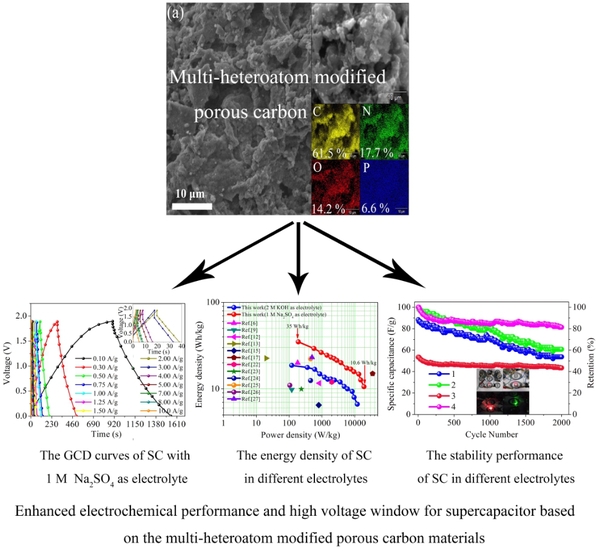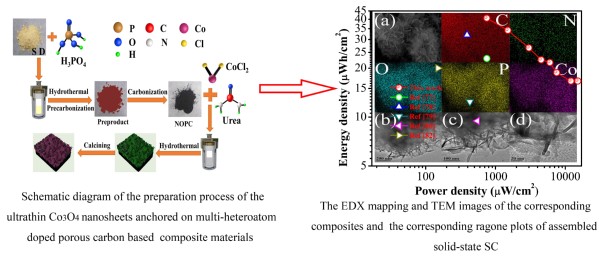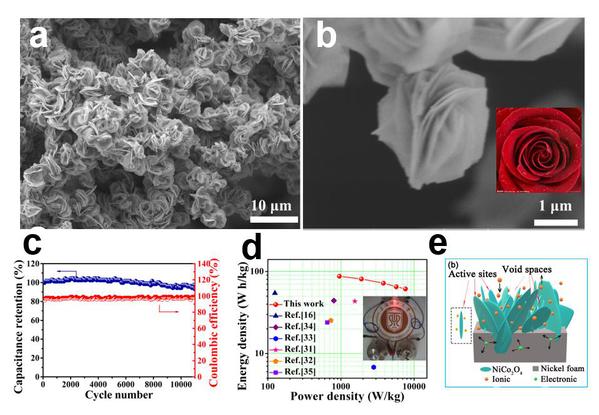The first research paper entitled “Enhanced electrochemical performance and high voltage window for supercapacitor based on multi-heteroatom modified porous carbon materials” has been published in internationally renowned journals chemical communications (Chemical Communications, 2019, (55) 10, 1486-1489), correspondence author as associate professor of Yajun ji.
As shown in the following figure, the preparation of multi-hybrid atom-doped porous carbon was achieved by mild acid etching under hydrothermal conditions with cheap biomass as the original material. In this paper, the effect of electrolyte on the performance of the device is investigated by applying the obtained materials to the supercapacitor. The study found that when sodium sulfate aqueous solution is used as electrolyte, the working potential of the device can be as high as 1.9 V, so the highest energy density of the device can reach 35 Wh kg-1. The method of preparing materials in this study is more green and simple, which reduces the cost of synthetic materials and pollution to the environment, and has great application potential in electrochemical energy storage. Corresponding link: https://pubs.rsc.org/en/content/articlelanding/2019/cc/c8cc08391f#!divAbstract.

The second work entitled Ultrathin Co3O4 nanosheets anchored on multi-heteroatom doped porous carbon derived from biowaste for high performance solid-state supercapacitor has been published in international famous journals Carbon ( Carbon, 2020, 156, 359-369) with independent correspondence author as associate professor Yajun Ji.
As shown in Figure, ultrathin cobalt oxide nanosheets were grown on the surface of porous carbon. Energy density of flexible solid-state supercapacitors based on the obtained materials can reach 40.5 μWh cm-2, which has a large competitive advantage compared with many other materials. As shown in Fig.2, the excellent electrochemical performance of the device could benefit from the rational construction and optimized design of the structure of resulted electrode material. Firstly, porous carbon provides a high specific surface area to absorb a greater amount of OH-. Secondly, the ordered structure of the Co3O4 nanosheets facilitates the rapid diffusion of OH-. Meanwhile, the presence of ultrathin nanosheets exposed more active sites to fully chemically react with OH-. Thirdly, the charge generated in the reaction can be rapidly transferred to the current collector via the porous carbon underneath which having a good conductivity. All the above results demonstrate that ultrathin Co3O4 nanosheets anchored on multi-heteroatom doped porous carbon matrix composites could have great potential for energy storage applications.
Corresponding link: https://www.sciencedirect.com/science/article/pii/S0008622319309728

Fig.1

Fig.2
On July 4th ,2019, the third research work entitled “High mass loading and high-density flower-like NiCo2O4 nanosheets on Ni foam for superior capacitance” was accepted by the internationally prestigious journal Chemical Communications (Chem. Commun.,2019, 55, 9128 10.1039/c9cc04135d). Postgraduate student Zhixiang Tong is the first author while Dr Yajun Ji is the corresponding author of this high-quality paper..
Electrochemical performance of ternary transition metal oxide materials significantly declines with increase of the mass loading, which limits their practical application. Herein, we report a simple route for high-density flower-like NiCo2O4 nanosheets with ultrahigh mass loading of 9.2 mg cm-2 on nickel foam to achieve superior capacitance. The as-assembled asymmetric supercapacitor yields a high energy density of 87.4 Wh kg-1 and an excellent cycle life with a 93.2 % capacitance retention after 11000 cycles. The results above suggest that the prepared electrode materials could have great potential for energy storage applications.

a SEM images of flower-like NiCo2O4 nanosheets on NF;b SEM images of flower-like NiCo2O4 nanosheets at higher magnifications;c cycling performance and coulombic efficiency at 20 mA cm-2 after continuous 11000 cycles, inset showing the profiles of the first five GCD cycles,and d Ragone plots of the NiCo2O4@NF//AC ASC device in comparison with other reported ASC devices and inset presenting the two ASC configurations connected in series to illuminate one LED. E,the advantages for charge storage of the 3D hierarchical high-density flower-like NiCo2O4 nanosheets based electrode.

